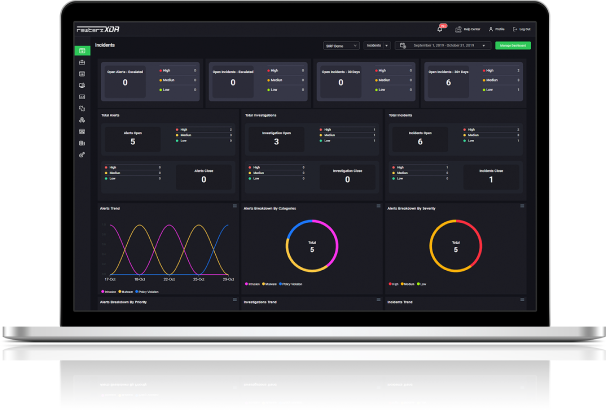

Rewterz Threat Alert – Lazarus APT Group – Active IOCs
January 23, 2022
Rewterz Threat Advisory – Multiple IBM Cognos Controller and XML External Vulnerabilities
January 24, 2022
Rewterz Threat Alert – Lazarus APT Group – Active IOCs
January 23, 2022
Rewterz Threat Advisory – Multiple IBM Cognos Controller and XML External Vulnerabilities
January 24, 2022Despite the fact that our lives were turned upside down in 2020, the cybersecurity sector rebounded in 2021. Every industry was turned upside down in 2020 but the cybersecurity sector rebounded in 2021 because, during the COVID-19 epidemic, cybercrime increased by 600%.
Cybersecurity firms rose to the challenge of operating in ever-changing conditions while continuing to deliver quality services to their customers.
The amount of unpredictability in cyberspace is something we can always count on. This is because, to avoid discovery, attackers will evolve their tactics, methods, and procedures frequently, making it difficult for defenders to keep up.
What are the key trends to watch in 2022?
What are the cybersecurity trends to watch for in 2022, and how can you react to these growing concerns? The following are some cybersecurity trends for 2022 that everyone should be aware of.
Cloud Infrastructure Attacks
- Attacks on cloud infrastructures are predicted to increase in 2022 due to the security risks these platforms pose. Organizations would more likely move more and new infrastructure to the cloud, allowing them to spend less time in running the operations of the cloud environment. Cloud-based environments make deployment easier, but they also introduce new cyber threats.
- More attacks are expected on these environments as a result of misconfiguration, vulnerabilities, and a lack of effective security management.
- As Hybrid cloud is adopted, on-premises attacks will not disappear.
As the cloud offers many advantages for businesses, enhancing security to address new vulnerabilities should be a top focus for organizations in 2022 as well.
Supply Chain Attacks
- Supply chain disruptions are difficult and expensive to repair thus the supply chain bottleneck that is presently affecting our global economy is projected to last long beyond 2022. Following the massive effect of the SolarWinds and Kaseya attacks, more supply chain attacks will most likely occur in 2022, in which criminal actors will target a service provider to get access to thousands of their clients at the same time.
- For the past few years, TCP/IP stacks and Real-Time Operating Systems (RTOSs) have been the primary targets, but there may be a greater emphasis on common implementations of application-layer protocols and security software development kits, such as for IoT connectivity, wireless protocol stacks, and libraries.
- In 2022, organizations will need to adjust swiftly to the growing danger of cybercrime, especially to secure important OT infrastructure. They will need to commit more resources to figure out how to exchange data to alleviate the supply chain bottleneck, cybercriminals will attack any weaknesses caused by preoccupied IT staff.
Ransomware Attacks

- Ransomware is perhaps one of the most widely publicized security threats of 2021 that caused havoc on organizations of all kinds. Unfortunately, it will continue to evolve and remain prevalent. First of all, contemporary ransomware will become more targeted and conspicuous, and ransomware operators will employ more sophisticated extortion strategies, such as data exfiltration, to weaponize it.
- Commonly utilized attack vectors such as VPNs, spear-phishing emails, and open RDP ports will continue to be employed. Due to an increasing attack surface from less-secure work from home settings, cloud and data center workloads will be the primary playground for ransomware perpetrators.
- DDoS attacks will be used by a growing number of threat actors to supplement ransomware campaigns. Given businesses’ regular capacity to withstand or mitigate DDoS attacks, DDoS attacks alone do not deliver a high return on investment for threat actors. Their impact is amplified as an extra extortion strategy against victims who are already dealing with ransomware.
- In continued efforts to disrupt the ransomware ecology or the ecosystems on which it relies like cryptocurrencies, law enforcement will employ increasingly extreme measures. It will restrict attackers’ freedom of action, but it won’t stop the most skilled ransomware groups.
- Threat actors will continue to discover the most effective technique from encryption to exfiltration and disclosure, ransomware will progress. The cost of extortion will be much outweighed by the time, effort, cash, and resources required to analyze, remediate, and recover. Payment under these circumstances might dramatically boost an organization’s survivability, making it the ideal leverage for the opponent.
Zero-Day Vulnerabilities

- Cybercriminals will be motivated by more media attention and large payments to launch an unprecedented number of zero-day vulnerabilities, surpassing the previous high of 2021.
- However, security leaders must continue to keep an eye out for older, known vulnerabilities. As organizations frequently struggle with sophisticated patch administration, old vulnerabilities are still exchanged and acquired in underground markets. Malicious actors will continue to take advantage of the rising patch gap within businesses in 2022.
Find out more about Zero-Day attacks in our Annual Threat Intelligence Report here.
Data Breaches
- Data breaches are becoming a common cybersecurity issue, especially in the healthcare industry as they are costing businesses a lot of money. Due to the Covid-19 outbreak, some healthcare organizations have relaxed access control regulations to allow staff to work from home. Therefore, healthcare firms need to pay more attention to security regulations in order to secure patient data.
IoT & 5G
- By 2022, the internet of things (IoT) is expected to have grown to 18 billion linked devices. The growth of IoT devices and 5G technology will be the most prominent cybersecurity trend in 2022 as they allow data to be transmitted between devices in an online environment. Therefore, the Internet of Things has the potential to become a serious cyber threat.
- In addition to all of the benefits of an IoT network powered by 5G technology, additional research, and protective measures are required to increase the network’s security against cyber-attacks. More firms are expected to invest more money on IoT projects in 2022, necessitating increased security.
Artificial Intelligence (AI)
- AI is becoming more important for every business as it processes more data quicker and more broadly than any human. For that reason alone, AI has a lot of promise in terms of detecting patterns of online behavior that might suggest impending attacks. Therefore, in the upcoming year, more organizations will invest in AI to detect and respond to cybersecurity risks.
Mobile Devices
- Mobile devices are used by most end-users to access e-commerce software and other online platforms. As a result, cybercriminals are focusing their efforts on mobile devices in order to target these individuals.
- The majority of attempted mobile transactions in recent years have been fraudulent. In 2022, companies and cybersecurity specialists will continue to face challenges from fraud, which is mostly driven by malicious applications.
Security Awareness
- Customers and users are the primary victims of cybercrime because attackers get access to their personal information. As a result, every organization should devise strategies to increase their security and safeguard their users and customers. To defend the organization’s reputation, it will become important to improve security awareness on how to avoid and recognize cyber-attacks.
Other Cybersecurity Trends
- Business Email Compromise (BEC) attacks will lead to big single-loss events that are both easier and faster to undertake, while ransomware will continue to dominate the headlines.
- As it becomes more difficult to maneuver across compromised settings undetected, attackers will prioritize speed above stealth. As a result, defenders will place a greater emphasis on the time domain.
To Put It Concisely,
You’ve probably heard that the epidemic has hastened the digital revolution and this upward trend shows no signs of abating. But what does the security of an organization entail in an increasingly flexible and hyper-connected world? The main cybersecurity concerns for the new year are predicted and mentioned in this blog by Rewterz, allowing for a more robust, forward-thinking security approach. These trends include ransomware, zero-day vulnerabilities, and other emerging security threats.
Also, check out our Managed XDR Service, which provides protection from various cybersecurity threats and helps organizations in responding to cyber threats that influenced the entire year of 2021 and will continue to do so in 2022.








